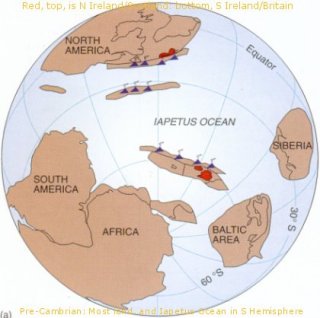The origin, nature and conditions required for the proliferation of life forms remains one of the great unsolved mysteries of science. One possibility receiving serious consideration is that the earliest life forms came to us from space – perhaps from a nearby planet like Mars (and hence the interest in the experiments on that planet of the Mars rover vehicle Spirit).
Certainly in its early life, Earth was continually bombarded by meteors, asteroids and comets. It is strongly believed that one massive early strike ripped a large part of Earth away, a fraction that itself over time conglomerated in orbit around our planet to form our moon. [By the way, did you know that a large rocky body orbiting a planet is called a moon: our moon therefore is unique in not having a name {like Colombo’s dog called dog}!] It is possible that the greater part of Earth’s water came from comets. It took some long time before Earth’s differentiation (core, mantle and crust) acquired its present separation and the crust cooled to form rocks. One of the abiding mysteries is how soon thereafter chemical life forms evolved.
We earlier determined to use the time period of one hundred million years [100Ma or 10 to the power of 8 yr] as our ‘step’. Earth’s history consists of 46 such steps. We will continue with this measure, and fractional parts thereof.
We must look to existing rocks for evidence of early life. The oldest extant sedimentary rocks that contain chemical fossils – i.e. chemical evidence within them that could only have originated from carbon life forms, are found in Greenland and are about 39 ‘steps’ old. Life therefore must be over 40 ‘steps’ old (to have become incorporated in this lithified structure!). The oldest proper fossil structures, stromatolites, formed from cyanobacteria (some of which are to be found on certain Australian beaches, making them also the most enduring, unevolved life form!) date from 35 steps back. It is twenty steps since the existence of [and the by-product of the former] excess oxygen, first formed the ozone layer and allowed eukaryotic cells (like plankton) to develop.
From twelve steps back there was a rapid diversification of these eukaryotic cellular forms. From ten steps back we had multicellular algae and from six steps back, multicellular animal forms. This period marked the move from Pre-Cambrian to the Phanerozoic Eon. Just half a step later these Ediacaran fauna were widespread. This led to the Cambrian Explosion of a wide variety of organisms with shells. By five steps ago, most phyla that exist today had emerged.
One of the greatest finds in geological history was of the Burgess Shales in the Rockies of Canada because they gave witness (from 520 Ma) of a great diversity of animal body plans, with soft-bodied predominating.
The next great move was from salt ocean to freshwater and land. The first plants and animals to make the move were small (e.g. spiders) but by 350Ma the land was colonised by giant fern-like trees and fish had become abundant in the seas. The first reptiles had evolved. Vertebrates were living on land. By 140Ma we had the first flowering plants.
If the numbers above had a decimal point in front, you could see each is a substantial fraction of one step, i.e. one hundred million years. Dinosaurs dominated the land for two steps (until ~65Ma when a meteor struck the Yucatan peninsula in Mexico, wiping out much of Earth’s life forms in addition to the dinosaurs). Thereafter small mammals dominated, and from them, about 6 million years ago, we [or rather, the homo species, the predecessor of homo sapiens sapiens – you and I] evolved.
I need another break!! I’ll return to relating this ‘big picture’ to Ireland of Silurian times, after I’ve had a ‘lie down’!
